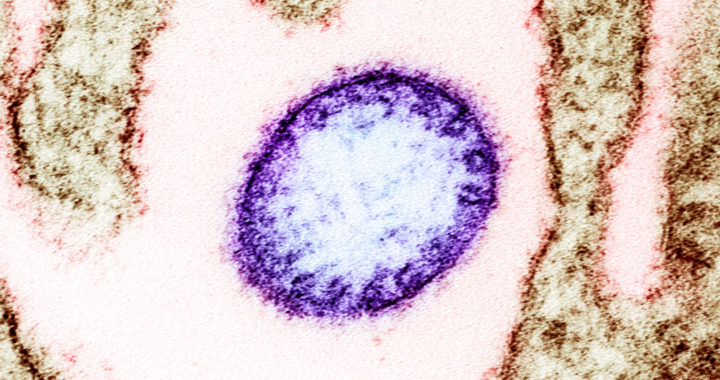The Nipah virus is the causative agent behind the Nipah virus infection in humans and other animals. It is a bat-borne virus that spread through exposure to contaminated secretions or tissues of infected bats or other animals such as pigs and even through human-to-human transmission. This makes the Nipah virus infection a zoonotic disease. The World Health Organization has included the virus in its list of viruses that are considered to cause future epidemics and has warned the public of its dangers due to its 40 to 70 percent fatality rate while the United States Centers for Disease Control and Prevention has regarded it as a Category C agent that might be engineered for mass dissemination as part of bioterrorism.
Explaining Nipah Virus and Understanding Nipah Virus Infection: How Does It Affect the Human Body and Why is It Considered a Deadly Virus
Nipah virus infection has a poor prognosis. It is fatal in 40 to 70 percent of cases. Some recorded outbreaks even had a 100 percent death rate. There is no specific treatment and option is limited to supportive care. Vaccines are also not available at the moment. This makes the virus one of the deadliest and most worrisome pathogens affecting the human population.
The infection can lead to serious conditions such as atypical pneumonia, severe respiratory distress, and encephalitis or brain inflammation. Those who survive the initial infection can struggle with debilitating long-term neurological sequelae which include memory loss, impaired cognition, seizures, convulsions, and personality changes.
Another troubling fact about the virus is that it can persist and lie dormant in survivors. The dormant virus can re-activate after several months or years after the initial infection. The signs and symptoms of infection due to its re-activation of the virus are similar to the initial infection and there are reported cases of deaths due to latent viral activity.
Background on Transmission and Infection
Remember that disease outbreaks involving humans due to the virus have always been zoonotic. This means that it infects the human population due to a spillover effect or when an individual is exposed to the contaminated secretions or tissues of infected bats or other animals such as pigs. This is the same route of transmission of zoonotic pathogens such as the Ebola virus that causes the Ebola virus disease and Ebola outbreak or the Marburg virus.
Studies have also revealed that human-to-human transmission of Nipah virus is also possible via close contact with an infected individual or exposure to contaminated body fluids such as blood, urine, and nasal secretions. This route of transmission is common in healthcare settings and has been considered a hospital-acquired infection.
Most do not consider this virus as airborne but there is a consensus that it can be transmitted from short-range exposure to contaminated respiratory droplets in close contact settings. It is also worth mentioning that a person can become infected via indirect transmission through contaminated fomites or inanimate objects. This route of transmission is common in cases in which there was no known direct contact with an infected animal or person.
Nevertheless, once exposed, the virus binds to the Ephrin type-B receptor 2 or EPH receptor B2 and Enphrin-B3 transmembrane proteins. EPH receptor B2 is encoded by the EPHB2 gene while Enphrin-B3 is encoded by the EFNB3 gene. These proteins mediate numerous developmental processes such as brain and nervous system development and maintenance.
Proliferation and Damage to the Human Body
Take note that the EPH receptor B2 and Enphrin-B3 proteins are located on the surface of a variety of different cell types. These include neurons, endothelial cells, the smooth muscle cells surrounding the arteries, lymphoid cells, respiratory epithelial cells, and cells in the sinusoidal lining of lymph nodes. Nevertheless, once the Nipah virus binds to either of these two proteins, it causes a conformational change in the viral envelope glycoprotein G.
Furthermore, after the conformational change, the viral envelope fuses with the host cell membrane, this allows the virus to enter and infect the cell. The virus then replicates and produces new viral particles. These new viral particles can then be released from the cell and infect other cells. The Nipah virus then proliferates inside the human body.
The range of cells it can infect explains how the Nipah virus affects the human body and the range of symptoms arising from a Nipah virus infection. Some cases are asymptomatic while symptomatic cases include common signs of respiratory infection such as fever, sore throat, coughing, and muscle pain, and neurological problems such as dizziness, drowsiness, headache, altered consciousness, confusion, and seizures.
Nipah virus specifically damages the human body first through direct damage to infected cells and the corresponding tissues and organs. The infection also triggers an inflammatory response that can heighten further tissue and organ damage. The virus also disrupts cell signaling and also interferes with the blood-brain barrier to proliferate in the brain.
FURTHER READINGS AND REFERENCES
- Ang, B. S. P., Lim, T. C. C., and Wang, L. 2018. “Nipah Virus Infection.” In eds. C. S. Kraft, Journal of Clinical Microbiology. 56(6): DOI: 1128/jcm.01875-17
- Hauser, N., Gushiken, A. C., Narayanan, S., Kottilil, S., and Chua, J. V. 2021. “Evolution of Nipah Virus Infection: Past, Present, and Future Considerations.” Tropical Medicine and Infectious Disease. 6(1): 24. DOI: 3390/tropicalmed6010024
- Skowron, K., Bauza-Kaszewska, J., Grudlewska-Buda, K., Wiktorczyk-Kapischke, N., Zacharski, M., Bernaciak, Z., and Gospodarek-Komkowska, E. 2022. “Nipah Virus–Another Threat From the World of Zoonotic Viruses.” Frontiers in Microbiology. 12. DOI: 3389/fmicb.2021.811157
Photo Credit: NIAID Integrated Research Facility/Adapted/CC BY 2.0

